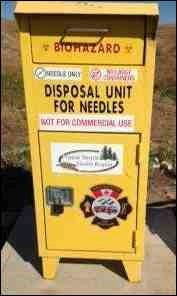Prairie North Health Region reminds the public to use the region's needle disposal boxes for the discarding of needles only.
The needle drop boxes are not to be used as recycling bins for used clothing or other personal or household items. Such inappropriate use poses risk to persons who may be attempting to deposit used needles in the drop boxes, as needle stick injuries from used needles could result.
The reminder follows the discovery of numerous articles of clothing - for the third time in the past year - in the needle drop box in the 1100 block of 102 Street in North Battleford. On each occasion, similar articles of clothing were discovered in the drop box, including several pairs of jeans, plaid shirt jackets, and winter coats.
"We believe some person or persons are mistakenly using the needle drop box as a clothing recycling bin," said Idella Barr, PNHR Sexual Health Coordinator. "The clothing appeared to be in good condition; however, if the person intended the articles to be recycled and used by others, this could not happen. The clothing had to be disposed of for fear that used needles had gotten stuck or concealed inside the items."
As an integral part of its Harm Reduction Strategy, PNHR operates used-needle drop boxes in North Battleford, Lloydminster and Meadow Lake. All of the brightly coloured yellow boxes are being clearly marked for 'Needles Only' and 'No Large Containers,' as well as with the Prairie North Health Region logo. The logo's presence is intended to convey that the drop boxes are for individual and community health and safety.
The 'Not for Commercial Use' decal on the drop boxes means that the containers are not to be used for disposal of diabetes supplies, veterinary or other medical sharps (needles).
Barr explained that the drop boxes are monitored routinely by designated Health Region staff and are cleared frequently for proper biomedical disposal.
The needle drop bins facilitate the safe disposal of used needles, removing them from circulation and reducing the risk of accidental needle stick injuries. The program lessens the improper disposal of needles and the possibility that needles will be re-used. This reduces the risk of transmission of blood-borne illnesses, particularly among injection drug users.




